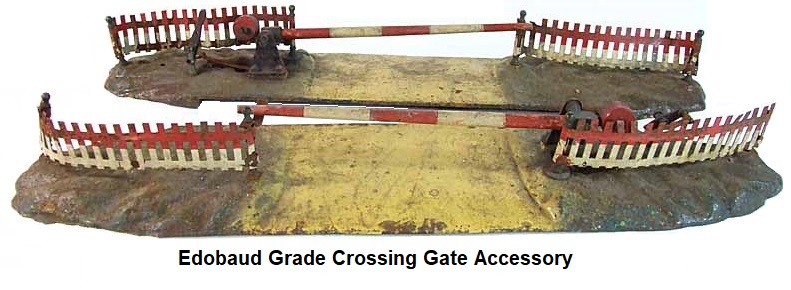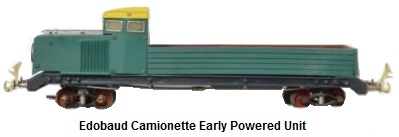 Edouard Baud operated a metal foundry in Villeurbanne (Rhône) France beginning in 1928 under the name of Ets Baud.
The company moved to Oyonnax, in Ain, in 1930 and changed its name to Edobaud. The name of the company was formed by
taking the founder's first name and last name and combining them. Baud brought with him his chief designer and technical
director Joannès Clausier. Shortly thereafter the firm began to develop products in the field of 'science toys'
(as advertised by Edobaud in its brochures).
This included a range of locomotives, freight wagons, passenger coaches, transformers, track and operating accessories in
'O' gauge. These model trains looked unusual as they were designed to operate on 'O' gauge track, but were more like 1
gauge (1/30) in weight and size. Edobaud toy trains and accessories were made out of steel, cast iron, brass, bronze,
nickel, aluminum, zinc, wood and tinplate, and were assembled by hand using nuts and bolts.
Edouard Baud operated a metal foundry in Villeurbanne (Rhône) France beginning in 1928 under the name of Ets Baud.
The company moved to Oyonnax, in Ain, in 1930 and changed its name to Edobaud. The name of the company was formed by
taking the founder's first name and last name and combining them. Baud brought with him his chief designer and technical
director Joannès Clausier. Shortly thereafter the firm began to develop products in the field of 'science toys'
(as advertised by Edobaud in its brochures).
This included a range of locomotives, freight wagons, passenger coaches, transformers, track and operating accessories in
'O' gauge. These model trains looked unusual as they were designed to operate on 'O' gauge track, but were more like 1
gauge (1/30) in weight and size. Edobaud toy trains and accessories were made out of steel, cast iron, brass, bronze,
nickel, aluminum, zinc, wood and tinplate, and were assembled by hand using nuts and bolts.
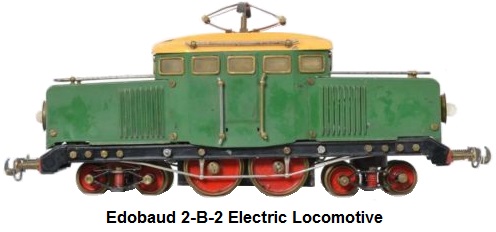 Initial product sales were exclusively handled by the famous French department store Galeries Lafayette in Paris.
Eventually the products began to show up in more specialized stores such as hobby shops. Edobaud produced at least five
different powered cars including two electric outline locomotives, a 'Camionette,' or powered van or truck, an 'Automotrice,'
or powered passenger car, and a small industrial type switcher locomotive. In 1931 Edobaud introduced its electric
locomotive called 'Tractor Simplon' (Cat. #35101) which was a model based on the Swiss-type 'Crocodile' prototypes that
operated during that period on the Alpine railways. This was referred to as a 2-B-2 type locomotive. Later in 1932 a 2-C-2
type followed. These locomotives were designed to run on 2 rails and were equipped with a universal motor and isolated wheels
that permitted remote control reversing. The initial offering of locomotives operated at either 110 or 220 volts AC, which
at the time was acceptable as a scinetific model, but considered dangerous as a children's toy. 3-rail versions equipped
with a center rail shoe pickup were made available by special order. The electric motors that powered these trains operated
at 12 - 18 volts. Both the 2-B-2 and the 2-C-2 Crocodile types from Edobaud were equipped with a pantograph that could be
wired for overhead power operation on layouts that were equipped with catenary systems.
Initial product sales were exclusively handled by the famous French department store Galeries Lafayette in Paris.
Eventually the products began to show up in more specialized stores such as hobby shops. Edobaud produced at least five
different powered cars including two electric outline locomotives, a 'Camionette,' or powered van or truck, an 'Automotrice,'
or powered passenger car, and a small industrial type switcher locomotive. In 1931 Edobaud introduced its electric
locomotive called 'Tractor Simplon' (Cat. #35101) which was a model based on the Swiss-type 'Crocodile' prototypes that
operated during that period on the Alpine railways. This was referred to as a 2-B-2 type locomotive. Later in 1932 a 2-C-2
type followed. These locomotives were designed to run on 2 rails and were equipped with a universal motor and isolated wheels
that permitted remote control reversing. The initial offering of locomotives operated at either 110 or 220 volts AC, which
at the time was acceptable as a scinetific model, but considered dangerous as a children's toy. 3-rail versions equipped
with a center rail shoe pickup were made available by special order. The electric motors that powered these trains operated
at 12 - 18 volts. Both the 2-B-2 and the 2-C-2 Crocodile types from Edobaud were equipped with a pantograph that could be
wired for overhead power operation on layouts that were equipped with catenary systems.
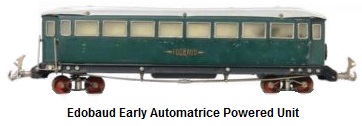 Joannès Clausier remained with Edobaud until 1933.
The company filed for a unique patent on March 2, 1933. They were awarded French Patent #751719 on June 26, 1933 for a
type of universal wound motor designed to operate devices on three rail track that had 3 separate insulated rails/blocks.
The motor was equipped with a special inverter that could 'walk' the electrical field and change direction as power to the
track was shifted. The motor was wired so that it ran in one direction when power was applied to the center rail hot shoe
and the wheels on one side. The motor would run in the opposite direction when power was applied to the center rail hot
shoe and the opposite side wheels. The entire patented system was unusual for the time, but well thought out and interesting.
Unlike similar train systems of the era offered by EHD, BLZ,
and Hornby, the Edobaud three rail system
with isolated blocks came with cars (engine included) who's wheels were completely isolated (insulated from the axles).
The locomotives had a double winding inductor, connected for each direction of travel to one of the outer rails through the
corresponding wheels (the current return was made via the armature, the collector and the shoe). Reversing of track current
from one outside rail to the other was facilitated via a toggle-type switch. This AC system provided a very reliable reversing
mechaism similar to those of DC systems operating with reverse polarity. Edobaud was awarded a second French patent for track
design on June 18, 1934. Edobaud three rail track had wooden ties, so all rails were completely insulated from each other.
Joannès Clausier remained with Edobaud until 1933.
The company filed for a unique patent on March 2, 1933. They were awarded French Patent #751719 on June 26, 1933 for a
type of universal wound motor designed to operate devices on three rail track that had 3 separate insulated rails/blocks.
The motor was equipped with a special inverter that could 'walk' the electrical field and change direction as power to the
track was shifted. The motor was wired so that it ran in one direction when power was applied to the center rail hot shoe
and the wheels on one side. The motor would run in the opposite direction when power was applied to the center rail hot
shoe and the opposite side wheels. The entire patented system was unusual for the time, but well thought out and interesting.
Unlike similar train systems of the era offered by EHD, BLZ,
and Hornby, the Edobaud three rail system
with isolated blocks came with cars (engine included) who's wheels were completely isolated (insulated from the axles).
The locomotives had a double winding inductor, connected for each direction of travel to one of the outer rails through the
corresponding wheels (the current return was made via the armature, the collector and the shoe). Reversing of track current
from one outside rail to the other was facilitated via a toggle-type switch. This AC system provided a very reliable reversing
mechaism similar to those of DC systems operating with reverse polarity. Edobaud was awarded a second French patent for track
design on June 18, 1934. Edobaud three rail track had wooden ties, so all rails were completely insulated from each other.
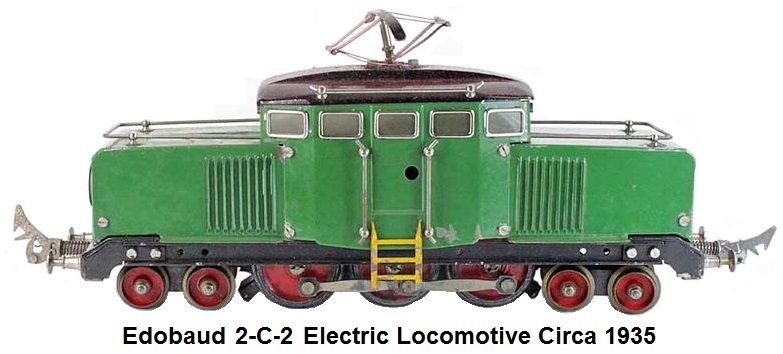 Edobaud produced eight different passenger cars: a First, Second,
and Third Class Car, a CIWL Dining Car, a CIWL Sleeping Car, and a Postal & Telegraph Car. All of the these cars were 18"
long, buffer to buffer, produced in tinplate, and painted a single color. They also produced a two-toned blue-cream tinplate
'Pullman' car and a green tinplate 'Fourgon de Queue' tail van or baggage car with sliding doors (Cat. #35111). All cars
feature painted
tinplate bodies, name and number decals, plain stamped aluminum roofs, individual metal and celluloid window inserts, steel
hand rails, flexible end-of-car diaphragms, heavy steel undercarriages with trusses, and wooden floors. Apparently, some
cars had provisions for lighting, but these are not common. The Edobaud coupling system consisted of a sprung hook and
pin arrangement, and later a hook and link arrangement.
Edobaud produced eight different passenger cars: a First, Second,
and Third Class Car, a CIWL Dining Car, a CIWL Sleeping Car, and a Postal & Telegraph Car. All of the these cars were 18"
long, buffer to buffer, produced in tinplate, and painted a single color. They also produced a two-toned blue-cream tinplate
'Pullman' car and a green tinplate 'Fourgon de Queue' tail van or baggage car with sliding doors (Cat. #35111). All cars
feature painted
tinplate bodies, name and number decals, plain stamped aluminum roofs, individual metal and celluloid window inserts, steel
hand rails, flexible end-of-car diaphragms, heavy steel undercarriages with trusses, and wooden floors. Apparently, some
cars had provisions for lighting, but these are not common. The Edobaud coupling system consisted of a sprung hook and
pin arrangement, and later a hook and link arrangement.
| Edobaud Bogie Freight Wagons |
| |
 |
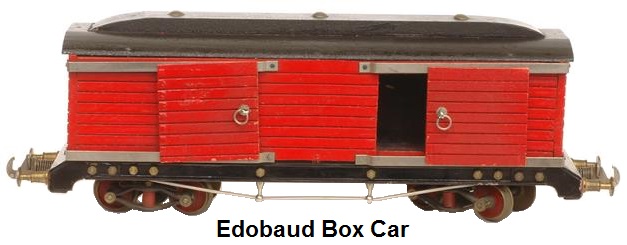 |
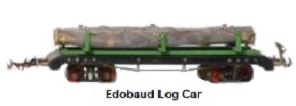 |
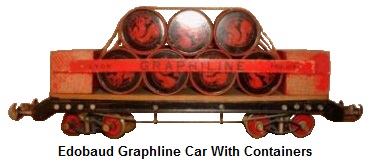 |
 |
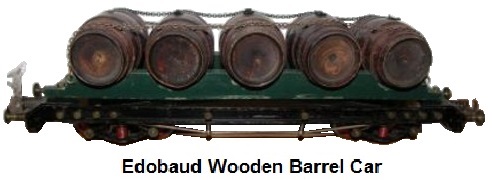 |
 |
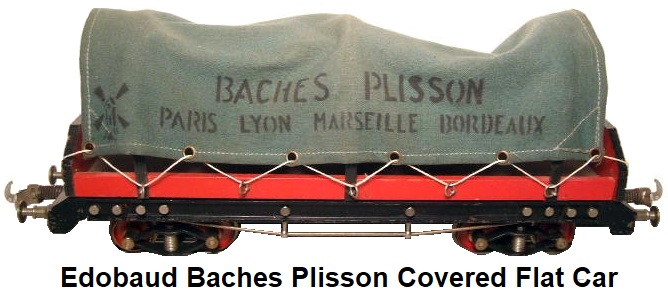 |
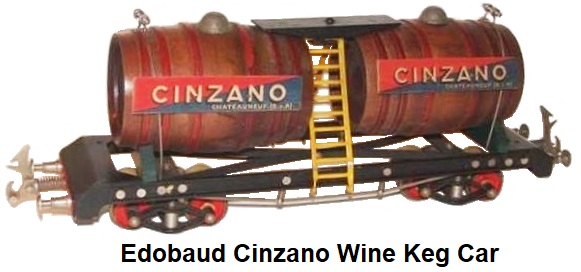 Edobaud produced nine separate freight cars: a Lumber Car (Cat. #35107), a "Graphiline" Grease Barrel Car (Cat. #35110),
a Box Car (Cat. #35104), a Flat Car (Cat. #35102), a Shell Tank Car (Cat. #35106), a covered (tarped) 'Baches Plisson'
Flat Car (Cat. #35109), a Gondola (Cat. #35103), a Wooden Barrel Car (Cat. #35105), and a 'Cinzano' Wine Keg Car (Cat.
#35108). Many of these cars relied on wooden topside components mounted on the usual heavy steel undercarriages. The cars
are 14" long buffer to buffer. Edobaud train accessories included a grade crossing, a truss bridge, an assortment of stop
signals, and a semaphore. Some of these signals were electrified and some were operated manually.
Edobaud produced nine separate freight cars: a Lumber Car (Cat. #35107), a "Graphiline" Grease Barrel Car (Cat. #35110),
a Box Car (Cat. #35104), a Flat Car (Cat. #35102), a Shell Tank Car (Cat. #35106), a covered (tarped) 'Baches Plisson'
Flat Car (Cat. #35109), a Gondola (Cat. #35103), a Wooden Barrel Car (Cat. #35105), and a 'Cinzano' Wine Keg Car (Cat.
#35108). Many of these cars relied on wooden topside components mounted on the usual heavy steel undercarriages. The cars
are 14" long buffer to buffer. Edobaud train accessories included a grade crossing, a truss bridge, an assortment of stop
signals, and a semaphore. Some of these signals were electrified and some were operated manually.
Edobaud packaged its trains either in sets or individually. The individual trains came in plain cardboard
boxes with separate lids labeled 'Jouets Scientifiques Edobaud'. Sets included the trains, a rheostat (or transformer in
later sets) and steel track. A full-size electric lightbulb was included in early sets that fit into a bayonette type socket
on the rheostat power control box. This was used as a mechanism to step down the 110v main voltage. Sets included pages of
detailed installation instructions and a small supply of grease to lubricate the locomotives. Edobaud issued catalogues that
were illustrated and many were printed in color.
Edobuad was not very well known outside of France, as they were only sold there. These unique trains
were very well made and many survive to this day. Because they were entirely hand assembled, limited quantities were
manufactured. However, over the years, despite their naive charm and 1930's provincial craftmanship, these trains were not
considered to be popular with collectors, either inside or outside of France. Edobaud disappeared around 1938 after 10
years of operation.
